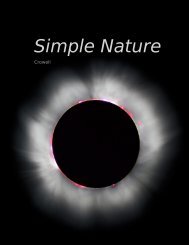The size of a radio antenna is closely related to ... - Light and Matter
The size of a radio antenna is closely related to ... - Light and Matter
The size of a radio antenna is closely related to ... - Light and Matter
You also want an ePaper? Increase the reach of your titles
YUMPU automatically turns print PDFs into web optimized ePapers that Google loves.
q / Graphs <strong>of</strong> loudness versus<br />
frequency for the vowel “ah,”<br />
sung as three different musical<br />
notes. G <strong>is</strong> consonant with D,<br />
since every over<strong>to</strong>ne <strong>of</strong> G that<br />
<strong>is</strong> close <strong>to</strong> an over<strong>to</strong>ne <strong>of</strong> D<br />
(marked “*”) <strong>is</strong> at exactly the<br />
same frequency. G <strong>and</strong> C♯ are<br />
d<strong>is</strong>sonant <strong>to</strong>gether, since some<br />
<strong>of</strong> the over<strong>to</strong>nes <strong>of</strong> G (marked<br />
“x”) are close <strong>to</strong>, but not right on<br />
<strong>to</strong>p <strong>of</strong>, those <strong>of</strong> C♯.<br />
played loudly or s<strong>of</strong>tly. In reality, waves on a string obey the principle<br />
<strong>of</strong> superposition approximately, but not exactly. <strong>The</strong> guitar,<br />
like just about any acoustic instrument, <strong>is</strong> a little out <strong>of</strong> tune when<br />
played loudly. (<strong>The</strong> effect <strong>is</strong> more pronounced for wind instruments<br />
than for strings, but wind players are able <strong>to</strong> compensate for it.)<br />
Now there <strong>is</strong> only one hole in our reasoning. Suppose we somehow<br />
arrange <strong>to</strong> have an initial setup cons<strong>is</strong>ting <strong>of</strong> two identical pulses<br />
heading <strong>to</strong>ward each other, as in figure (g). <strong>The</strong>y will pass through<br />
each other, undergo a single inverting reflection, <strong>and</strong> come back <strong>to</strong><br />
a configuration in which their positions have been exactly interchanged.<br />
Th<strong>is</strong> means that the period <strong>of</strong> vibration <strong>is</strong> half as long.<br />
<strong>The</strong> frequency <strong>is</strong> twice as high.<br />
Th<strong>is</strong> might seem like a purely academic possibility, since nobody<br />
actually plays the guitar with two picks at once! But in fact it <strong>is</strong> an<br />
example <strong>of</strong> a very general fact about waves that are bounded on both<br />
sides. A mathematical theorem called Fourier’s theorem states that<br />
any wave can be created by superposing sine waves. Figure p shows<br />
how even by using only four sine waves with appropriately chosen<br />
amplitudes, we can arrive at a sum which <strong>is</strong> a decent approximation<br />
<strong>to</strong> the real<strong>is</strong>tic triangular shape <strong>of</strong> a guitar string being plucked.<br />
<strong>The</strong> one-hump wave, in which half a wavelength fits on the string,<br />
will behave like the single pulse we originally d<strong>is</strong>cussed. We call<br />
its frequency f o . <strong>The</strong> two-hump wave, with one whole wavelength,<br />
<strong>is</strong> very much like the two-pulse example. For the reasons d<strong>is</strong>cussed<br />
above, its frequency <strong>is</strong> 2f o . Similarly, the three-hump <strong>and</strong> four-hump<br />
waves have frequencies <strong>of</strong> 3f o <strong>and</strong> 4f o .<br />
<strong>The</strong>oretically we would need <strong>to</strong> add <strong>to</strong>gether infinitely many<br />
such wave patterns <strong>to</strong> describe the initial triangular shape <strong>of</strong> the<br />
string exactly, although the amplitudes required for the very high<br />
frequency parts would be very small, <strong>and</strong> an excellent approximation<br />
could be achieved with as few as ten waves.<br />
We thus arrive at the following very general conclusion. Whenever<br />
a wave pattern ex<strong>is</strong>ts in a medium bounded on both sides by<br />
media in which the wave speed <strong>is</strong> very different, the motion can be<br />
broken down in<strong>to</strong> the motion <strong>of</strong> a (theoretically infinite) series <strong>of</strong> sine<br />
waves, with frequencies f o , 2f o , 3f o , . . . Except for some technical<br />
details, <strong>to</strong> be d<strong>is</strong>cussed below, th<strong>is</strong> analys<strong>is</strong> applies <strong>to</strong> a vast range <strong>of</strong><br />
sound-producing systems, including the air column within the human<br />
vocal tract. Because sounds composed <strong>of</strong> th<strong>is</strong> kind <strong>of</strong> pattern<br />
<strong>of</strong> frequencies are so common, our ear-brain system has evolved so<br />
as <strong>to</strong> perceive them as a single, fused sensation <strong>of</strong> <strong>to</strong>ne.<br />
Musical applications<br />
Many musicians claim <strong>to</strong> be able <strong>to</strong> pick out by ear several <strong>of</strong> the<br />
frequencies 2f o , 3f o , ..., called over<strong>to</strong>nes or harmonics <strong>of</strong> the fundamental<br />
f o , but they are kidding themselves. In reality, the over<strong>to</strong>ne<br />
372 Chapter 6 Waves














